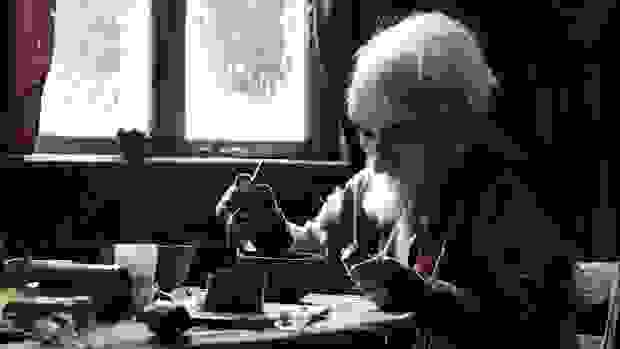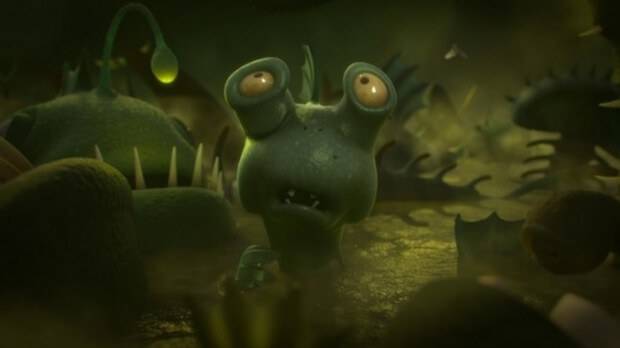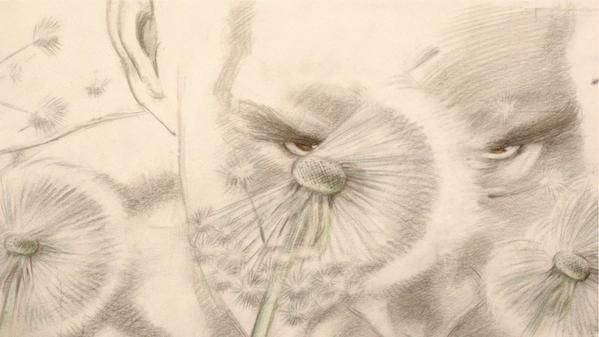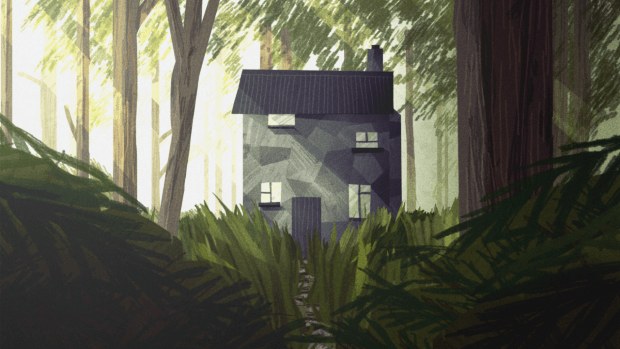Encounters 2015: Animation Highlights (Part 2)
The second batch of international animation screenings proved to be a bumper crop of outstanding films. A mix of comical, warmhearted – as well as dark and sometimes gruesome – tales woven out of the most diverse range of animation techniques. Picking up after part 1 of our overview with Animation 4: Friends and Family, a feel-good screening filled with comedy, touching moments and altogether beautiful animations, fulfilled its purpose of uplifting the audience with gusto. There were many standout films in this upbeat screening.
Among the many standout films are Bundle of Joy by Robert Milne, which used a common squeaky toy to narrate a story of a wind-up mouse couple as they embark on their loving life together. Brightly coloured and highly cartooney, the film puts you in mind of many pre-school children’s TV series. As the couple embarks on their quest to become parents we soon see just what this little ‘bundle of joy’ does to the couple’s neat house and their precise but happy life, with a slightly dark but comical ending.

The Old Man & The Bird (Dir. Dennis Stein-Schomburg)
On a more somber note, The Old Man and the Bird by Dennis Stein-Schomburg is an extraordinary visual tale that sees an elderly man alone in a run-down hut as he attempts to survive in the harsh winter, but when a robin flights into his window, the old man has to decide whether to help the creature by facing the treacherous cold outside, despite his ailing body. Dark, beautiful and haunting, the mixture of techniques left everyone I talked to including myself speculating as to just how it was created; seemingly a mixture of stop-motion, computer animation and perhaps live action puppetry.
Snowfall by Conor Whelan is a film that touches upon the idea of fleeting love, how we interact with one another and those seemingly insignificant moments that change your whole perspective. Conor’s use of morphing and different ways of framing shots creatively speeds up the storytelling process and there are some truly elegant scenes of animation that showcase his technical ability. Short, exacting and pointed, it leaves the audience wanting more, much like a lost thought or lingering eye contact between strangers at a party.
A film that we have spoken quite highly of in the past but grabbed the audience’s attention once again was Mend and Make Do by Bexie Bush (you can read our director interview here). This magnificent film from last year’s NFTS crop is still worthy of a mention for its ability to captivate an audience, make them laugh, think and truly feel for the central character. It is Bexie’s sensitivity as a director, her characteristic style of animation and genuine connection to her subject that speak volumes in this delightful and charming life story.
The screening ended with We Can’t Live Without Cosmos by Konstantin Bronzit which was, quite simply, brilliant. There has been quite a lot of hype around this film within the industry and rightly so, as it is both instinctively funny and effortlessly moving. Truly capturing the love and admiration between lifelong friends, the narrative takes the audience deeply into the life of the two central characters (cosmonauts in training gearing up for their first voyage) and demonstrates the true ability of animation to strike both the heart and the funny bone. It was a very wise move on the curator’s part to place this film last in the running order as it left audience buzzing and chatting right out of the screening.
Animation 5: Rise and Fall seemed to split the audience. Many people I spoke to after seemed to have mixed opinions of this collection of films that dealt with struggle, success and change, though I personally felt this was the best screening of the week. Ray’s Big Idea by Steve Harding-Hill of Aardman goes right back to the primordial ooze as we see Ray, a bog-dwelling fish creature, using his new grown legs to climb to the surface in an evolutionary struggle to better his situation. Jovial and extremely well-timed, this film reminds us with glaring clarity that Aardman and their talented directors remain masters of physical comedy.

Ray’s Big Idea (Dir. Steve Harding-Hill)
The film that truly seemed to split the overall audience at this year’s festival was The Master by Riho Unt. The story is dark and perhaps a little overlong, but I have to admit this was one of my favourite films, showing the true brutality of nature and the animal kingdom as a dachshund and chimp are left to fend for themselves in the absence of their Master. With no dialogue and incredibly sophisticated stop-motion animation, the film left the audience perhaps uneasy at the true brutality of survival and chaos when pushed to the brink. It was fascinating to see how the director portrayed the creatures as they experienced vice and compassion thorugh the interaction between a freed, empowered primate and a submissive, loyal canine.
Pa. by Kapitolina Tcvetkova-Plotnikova follows a man as he narrates his worthless (as he sees it) life in the form of a letter, laying himself bare to the audience. When a story is allowed to breath through expert editing, the medium of short film truly shows its full worth, as is the case in this film. The stark stop-motion animation of Élodie Ponçon’s White makes use of 3D-printed white characters against white backgrounds, created a fresh, clean environment in which she conveys a story of change, exclusion and accepting your fate. Anther strong film was Block and Piled by Marc Riba and Anna Solanis – the characters were fun, the animation was well executed and the story, while weir, was altogether sweet and generally served as welcome break after the more severe films in this screening.
Concluding this screening was the hugely anticipated English debut of world-renowned animator Richard Williams’s new short film Prologue. This astonishing piece of hand-drawn animation made use, as you would expect, of many of the skills only found in an animator of this quality; from the perfect figures to the use of colour, morphs and dynamic movement. The film set a precedent to all other filmmakers in attendance as to just what is possible in animation and just why it is such a unique and brilliant art form. The brutality of the fight scene was surprising but was extremely well executed and was a real testament to Williams and his artistic range. You can hear our recent interview with Richard Williams on the making of this superb film below:
The final international animation screening was A Breath of Fresh air, films on the theme of the natural world and its affect on humanity and our surroundings. First off, The Walk by Stephen Middleton which comprised of a montage of stylised, well-constructed background scenes was not so much a narrative piece as a testament to the beautiful vistas of the lake district. Aubade by Maro Carraro demonstrated the power and the artistic inspiration that can be derived from experience. Inspired by a concert he attended, Carraro has managed to create a piece that truly represents that moment of utter awe in the presence of a perfect moment, whether that be in the scenery around you or music that touches you deeply.
This screening was full of highly stylised and visually striking work, none more so than Nino Christen’s Black Island. The stark, black and white film is reminiscent of inked comic strips and tells the story of a isolated gatekeeper who resides at the edge of a vast wood. Distracted by a radio obtained during a trade, devastation occurs in the forest behind him. The use of stark, chromatic colours and patterns within this film works well with the story of loneliness and boredom. The charcoal animation Islander’s Rest by Claudius Gentinetta and Frank Braun was a film that stood out due to the wonderfully created backdrops and scenery around the solemn tale of a woman who creates detailed ships in bottles in return for drinks, told from the point of view of young tavern child. The film creates a great sense of atmosphere, although some scenes are perhaps overlong or repeated one too many times, this adds to the sense of monotony and the pathos of the overall film.
On a lighter note, If the Cuckoo Don’t Crow by Steve Kirby (which received a DepicT! award) is constructed around a radio call-in show in which a man tells the tale of a British hurricane that was pre-empted by his mother. The positive reaction of the audience was a testament both to the choice of story and perfectly timed visuals.
A somewhat guilty pleasure was Dead Air, a mix of realistic CGI and live-action characters, about a pirate radio station that sets up base around the coast of the island. Comical and witty, the film shows how over time the radio host’s initial indifferent outlook is changed over time by his new fans. As someone who grew up on island, the film really captured the small-mindedness and often backwards thinking of a small community and the flippancy of people who seek to make changes to a town or community stuck in their ways; the radio host is ultimately swallowed by his ego and self-importance. All in all the scripting in the film was extremely well thought-out and the animation served as an aid to the director’s comical musing on island life.
Altogether the screenings represented a great cross-section of surreal, abstract and narrative based films, a bumper crop of eccentric and moving films which I have come to expect from this truly unique festival. This festival often offers a brilliant platform for new film makers, as well as new work from well-known and acclaimed industry professionals. There were some truly unique gems in this edition, which we are sure to see do the rounds as the festival year continues.



